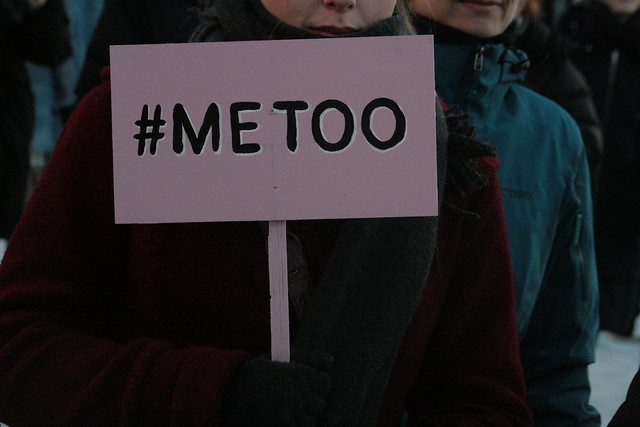On the "caution" of some reporters covering the #MeToo movement

Since the start of the MeToo movement, journalists have played a key role in holding perpetrators accountable for the sexual violence they allegedly committed. In November 2018, Julie K. Brown's reporting on the late billionaire Jeffrey Epstein for the Miami Herald aided his July arrest, and the reporting of The New Yorker's Ronan Farrow and Jane Meyer and the New York Times' Jodi Kantor and Megan Twohey helped bring down influential figures -- most notably producer Harvey Weinstein.
Some reporters, like Ronan Farrow, have framed this work as ultimately about exposing power, especially how institutions are willing to protect and cover-up powerful abusers. But, unfortunately, instead of challenging society's instinct to protect powerful men, some reporters covering #MeToo have reproduced this bias.
Take Jane Meyer's recent New Yorker piece, "The Case of Al Franken," for example. Meyer takes a sympathetic look at comedian-turned-Senator Al Franken who, in 2017, resigned from the Senate after being accused of sexual misconduct by conservative radio host Leann Tweeden. Tweeden claimed Franken kissed her without her consent during a comedic sketch in a 2006 USO tour. A few weeks later, a photograph surfaced of the Senator mimicking groping her breasts while she slept.
Meyer's article picks apart Tweeden's accusations, debunking her claim that Franken wrote the skit specifically to kiss her. The reporter interviewed two other actresses, Karri Turner and Traylor Portman, who performed the skit on previous USO tours with Franken. Meyer also questions the journalistic ethics of the conservative radio station that broke Tweeden's story, KABC-AM, without fact-checking it or giving Franken an appropriate amount of time to respond (they only reached out to Franken for comment after they had already published the story).
Conservative media may have co-opted Tweeden's story for political gain, but what do we make of such an objectively problematic photograph? Or the seven other women who also accused Franken of inappropriately touching them?
Instead of adequately addressing these questions, Meyer quotes sources that fail to address Tweeden's claims directly. Senators who regret demanding Franken's resignation, as well as his SNL colleagues, emphasize that Franken is "five hundred percent devoted" to his wife and "the very last person who would be a sexual harasser." While Meyer does quote the Franken's seven other accusers, she also balances their accounts with Franken's thoughts on the matter. "I'm a very physical person," Franken told Meyer.
This analysis identifies a significant blindspot in the MeToo movement — its tendency to excuse less extreme #MeToo experiences. Meyer's dismissal of Franken's accusers reproduces this blindspot which, in turn, contributes to her analysis of Franken's punishment as disproportionate to his actions. This take is implicit from the very beginning of the article when Meyer describes Franken's current home in Minnesota as "a cave where someone hides out from the world."
Instead of dissecting Franken's — or any other individual's — personal morality, perhaps we should evaluate the standards to which we hold people accused of misconduct more generally. As Catherine Cauterruci argued in Slate, "The key question here is whether Franken's behavior, in aggregate, means he doesn't deserve a place in the U.S. Senate."
Meyer isn't the only reporter guilty of this approach. In June, The New York Times also came under fire for downplaying survivors' voices after they minimally covered writer E. Jean Carroll's accusation that President Trump assaulted her. According to The Cut, the outrage stemmed from The Times "omitting the story from its home page, waiting two days to run a piece in print about the allegations, and publishing the story in its "Books" section." In a mea-culpa, The Times' Executive Editor Dean Baquet admitted the publication had been "overly cautious."
On the one hand, this explanation is baffling. Why be cautious when 16 other women have accused Trump of inappropriate behavior, and he bragged about this behavior himself in the now-infamous Access Hollywood interview? On the other hand, it fits with a larger editorial pattern of "cautiousness" in the face of controversial issues. The same approach was evident in August, after the shootings in Dayton and El Paso, when The Times ran the headline "Trump Urges Unity Vs. Racism." This headline angered many who see the President's divisive racial rhetoric as directly responsible for the attacks.
The word "cautious" indicates timidity laced with fear—fear of holding influential people accountable for their behavior, and fear of being lambasted for not giving weight to "both sides" of an issue. But attempting to be "cautious" isn't always as neutral as it appears. Meyer's argument assumes a blunt moral binary that excuses inappropriate behavior like Franken's. Meanwhile, the decision to underpromote E. Jean Carroll's story is yet another off-shoot of the indifference and apathy that has allowed Trump, and men like him, to get away with so much. The media's reservation, therefore, begs the question: when does caution become biased protection?
More articles by Category: Feminism, Media
More articles by Tag: Rape, Sexism, Sexual harassment, #MeToo



























